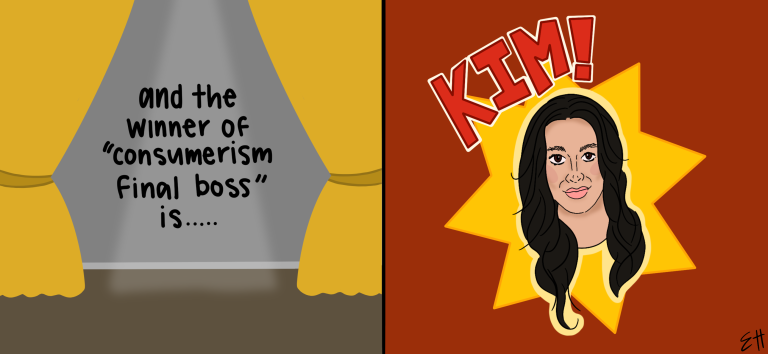As he traveled through Rome in 2017, Hoosier artist Tom Keesee decided to record the grandeur that surrounded him by sketching what he saw in self-made notebooks. Carrying a small three-ring binder, Keesee embraced the lifestyle of a traveling artist as he explored Italy by train with only $50 a day. After visiting famous sites such as the Vatican, the Colosseum and the cityscapes, Keesee was able to compile the scenes in front of him as sketches and later turn them into finalized pieces of work.
The public can see his finished work, which took around a year to complete, on display at the Christel DeHaan Fine Arts Center Gallery until March 15. When speaking at the gallery’s opening on Feb. 18, Keesee explained how he studied the world of classic painters and borrowed their techniques.
Keesee said that he relies on optical illusions in his work, including one that tends to make the viewer switch dominant eyes to achieve a new perspective while looking at a piece. When looking at a building, because of the length, one eye will start looking at the object and as it comes closer or further from the, the other will take over, Keesee said. This was not a concept that he made up, it has been around for ages, Keesee said, but he utilizes that natural switch to make his drawings look more realistic. Traveling gives him an opportunity to find new subjects and views, he said.
“I always enjoy travel. It’s always so much fun,” Keesee said. “I make lots of mistakes, I do things that frustrate me, things happen…You always have things going wrong, you can’t avoid it. But that’s part of the beauty in it—it’s a challenge. You have to be up, you [have] to be thinking [and] you [have] to be kind of physically fit.”
For inspiration, Keesee said he has turned to watercolor techniques that were popular in England during the 1700s and 1800s. He learned from his study of classical artists that in order to sketch the places that he visited in a timely and accurate manner, he had to refer back to old techniques of drawing, such as drawing the negative space of images first and then moving to small details.
While some of his depictions are constant, such as buildings or statues, Keesee also likes to sketch and paint subjects he considers larger than life, which include sunrises, sunsets and the night sky.
“You really feel small when you’re out in the dark looking at the stars. You feel tiny, and everyone I’ve met has had that experience and that’s part of what I put into my paintings. It’s why I go to Rome. Because you go to some of these churches, some of the ancient sites and they are made to make you feel tiny. It’s all about this overwhelming kind of grandeur experience,” Keesee said. “ The Colosseum has it, the Vatican obviously has it—it’s made to make you feel tiny, tiny, tiny. So that theme I think is consistent in all my work, it’s just the subject keeps changing: landscapes, cityscapes, whatever, but it’s always that theme that I’m trying to capture.”
Gallery Coordinator Mark Ruschman said that he has known Keesee for years and invited him to display his work in the gallery. After meeting Keesee in a gallery on Massachusetts Ave. in Indianapolis in the 1980s, Ruschman said he saw that Keesee’s work connected to what students in the university’s art classes are taught. Ruschman said that with every artist he brings to visit UIndy, he hopes that their work will connect back to what is being taught in various art classes and provide the public an opportunity to view interesting work.
“How he [Keesee] was talking about how he constructs a painting, constructs a drawing first, the number of drawings that he does, his focus, and then he brings the drawings back to finish the watercolors,” Ruschman said. “That allows him to work much more quickly. So all the experiences he talked about today are valuable for the students here to learn and the general public to learn too.”
Senior environmental science and earth science major Stephanie Burdsall helped set up the gallery as part of a course she is enrolled in. Burdsall said the the student gallery studies class knew about each piece in advance because they were given resources—such as a typed explanation and Keesee himself—to learn about the pieces before the exhibition.
Keesee was interactive and helpful to the gallery studies class, Burdsall said, especially in regards to the learning process of the work. When he initially came in and set out his pieces, she said Keesee stopped to talk with students who paused near the display and explained the meaning behind the work and the processes he used to create them.
“Tom [Keesee] seemed really lenient, pretty laid back. He came and pretty much said, ‘Do whatever you want [when putting together the gallery], you don’t even have to use all of the pieces you can give back anything you don’t want,’ so he was great,” Burdsall said. “He would [sometimes] give suggestions, and other times, he would be like ‘I love how you set that up, that’s perfect, you don’t have to change anything.’”
Keesee said he plans to continue creating and traveling. It is part of an artistic career that he said he has been steadily expanding since he was a child.
“My mom, didn’t realize this, she bought me a small kit of oil paints when I was four years old, which was a huge mistake,” Keesee said. “…I was always told I had talent. Every art class, every class I was in, I was always told me, ‘Oh, you’re the best drawer in the class,’ and that just inspires anybody, any young person to just keep making drawings. So I’ve been drawing my whole life. I don’t ever remember a time not drawing. I’ve just hope I’ve gotten better.”






